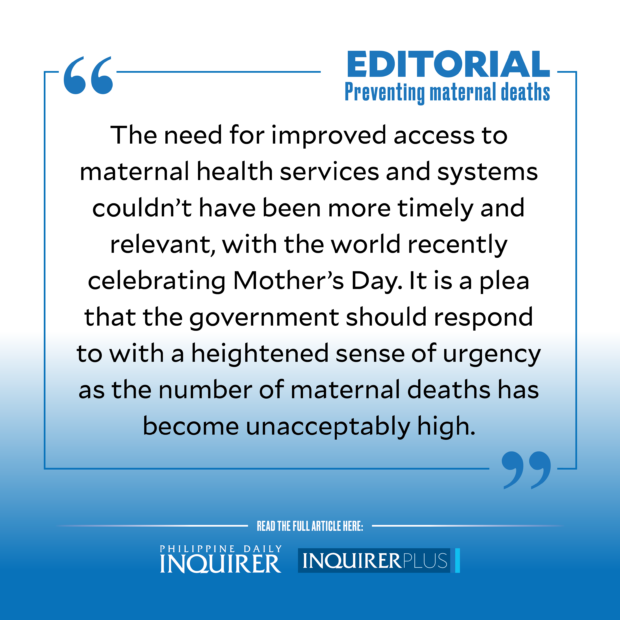Preventing maternal deaths

After a mother carries a child for nine months, finally giving birth should be a rewarding and fulfilling experience worthy of celebration, certainly not one that ends in tragedy. Sadly, such has been the case in the Philippines where the number of maternal deaths has been rising at an alarming pace.
From 1,458 deaths in 2019, the number almost doubled to 2,478 in 2021, which is equivalent to six or seven women dying every day during and following pregnancy and childbirth. Before 2021, the Department of Health pegged the highest number of maternal deaths at 2,511 in 1952, and 2,645 in 1951. This makes 2021 the third deadliest year for childbearing in the Philippines in 69 years, according to Juan Antonio A. Perez III, former undersecretary and executive director of the Commission on Population and Development.
Worse, many of these deaths could have been avoided, as underscored by the United Nations Population Fund (UNFPA).
“Women die because sexual and reproductive health services are unavailable, inaccessible, unaffordable, or of poor quality. Human resources are also scarce. There are not enough trained health-care workers [who] provide quality sexual and reproductive health information and services,” noted UNFPA country representative Dr. Leila Saiji Joudane.
The need for improved access to maternal health services and systems couldn’t have been more timely and relevant, with the world recently celebrating Mother’s Day. It is a plea that the government should respond to with a heightened sense of urgency as the number of maternal deaths has become unacceptably high.
According to the World Health Organization (WHO), the major complications during and following pregnancy and childbirth that account for nearly 75 percent of all maternal deaths include severe bleeding and infections resulting from complications after delivery.
Fortunately, these complications can be managed, the WHO said. For one, all pregnant women should be encouraged to give birth in a hospital or birthing facility where they can be cared for by a skilled birth attendant. Regular prenatal checkups also help ensure a safe pregnancy and delivery.
In the Philippines, however, the UNFPA lamented that 14 percent or just over one in 10 pregnant women do not get regular prenatal checkups. As few women do not give birth in health facilities or get help from skilled birth attendants.
Joudane also bemoaned the lack of trained healthcare workers in the Philippines who can provide quality sexual and reproductive health information and services, with only one public health midwife for every 1,300 women and girls of reproductive age. The high cost of health care also makes these vital services inaccessible to too many poor Filipino women.
This dire situation that has led to a disturbing rise in maternal deaths was made worse by COVID-19, as mobility restrictions and economic disruptions prevented many expectant mothers from going to hospitals or clinics for checkups and childbirth. A 2020 study by the UNFPA and the University of the Philippines Population Institute also noted that attention and resources for women’s health might have been diverted, as national and local health systems became overwhelmed by the necessary response to COVID-19 patients.
But while COVID-19 was certainly a major factor behind the near-doubling of the number of maternal deaths from 2019 to 2021, it is not entirely to blame. It only trained a harsh spotlight on the glaring shortcomings in maternal health care, as well as the systemic discrimination against women and girls that directly leads to maternal deaths. Unwed mothers could also be made to feel unwelcome in birthing facilities, forcing them to turn to the more dangerous alternative of giving birth outside health centers.
Said Joudane: “Gender inequality is what keeps women out of the workforce and schools, [makes them] vulnerable to conflict and violence, and denies them the right to make decisions about their own bodies and health. And it’s what makes pregnancy a dangerous endeavor, one which hundreds of thousands of women do not survive.”
These are tragedies that the Marcos administration can help prevent by doubling down on efforts to meet the Philippines’ commitments under the United Nations’ Sustainable Development Goal (SDG) to cut preventable maternal deaths by 2030. Indeed, the Philippines has some serious catching up to do, with the 2022 report by the Philippine Statistics Authority indicating that progress on meeting this particular SDG goal “needs acceleration.”
The Marcos administration can burnish its legacy by intensifying coordinated efforts among the concerned agencies. As the UNFPA has recommended, there is a need to mobilize and reinvigorate national and community-level commitments to end preventable maternal mortality. “No woman should die giving life,” Joudane stressed, a mantra that bears repeating.




















